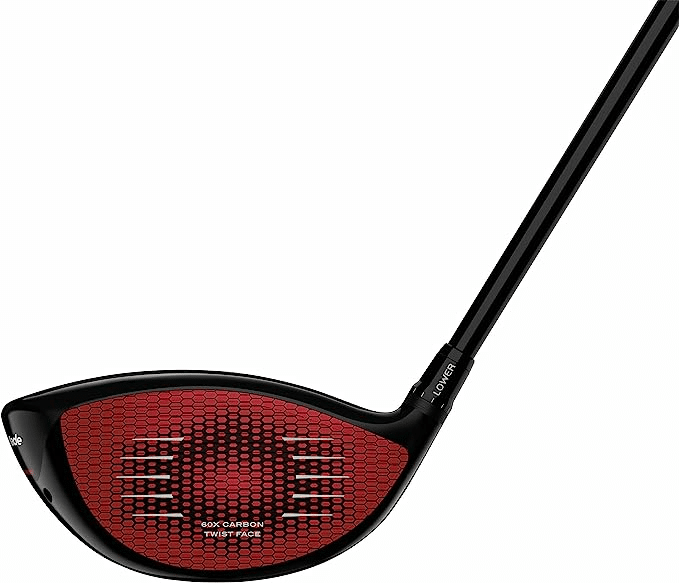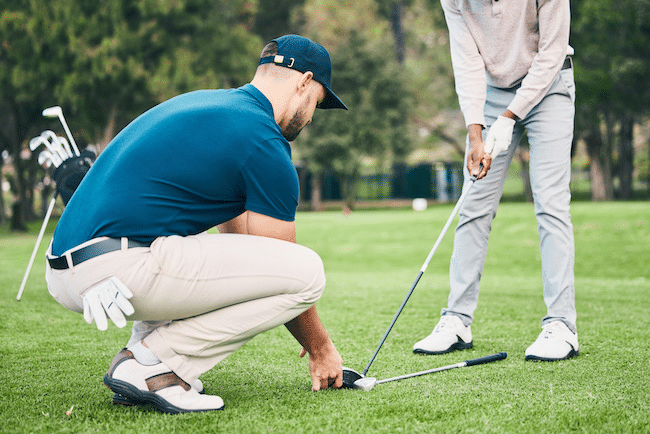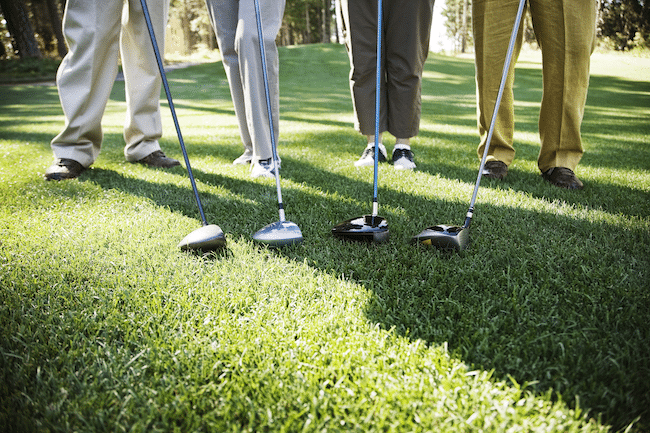The decision between a driver and a 3 wood can be particularly challenging, as each club boasts distinct attributes that cater to different aspects of the game.
Driver vs 3 wood: what are the differences? A driver has lower loft and more distance, making it hit farther but harder to control. Its clubface is also larger for forgiveness. A 3 wood has higher loft, smaller clubface, and is more versatile. Drivers are for long tee shots, while 3 woods can be used for various shots.
This comprehensive guide will examine the nuances between a driver vs 3 wood, their advantages, and the factors to consider when choosing the perfect club for your specific needs and playing style.
Understanding the key differences between these clubs can help you make the right choice for your game.
Differences Between Driver vs 3 Wood: A Comprehensive Breakdown

Choosing between a driver and a 3 wood can be time-consuming. With so many factors to consider, it’s easy to feel overwhelmed and unsure which club to use. Learn about both clubs’ design, performance, and playing characteristics.
Clubhead Size And Shape: Balancing Forgiveness And Control
The size and shape of the clubhead are among the most striking differences between a fairway wood and a driver. Drivers boast larger, rounder clubheads that maximize forgiveness on off-center hits, a crucial factor when seeking top-tier distance off the tee.
Conversely, 3 woods feature smaller, compact clubheads, granting enhanced accuracy and control in various playing situations.
Shaft Length: The Power And Precision Trade-Off
The basic rule of thumb is to go for 3 wood instead of a driver if shaft length is your priority. A driver’s shaft is generally longer than a 3 wood’s, boosting clubhead speed and yielding greater distance.
However, this increased 3-wood length can also complicate club control and swing consistency. Meanwhile, the shorter shaft of a 3 wood offers more stability and control, making it easier to hit the ball consistently.
Loft Angle: Influencing Launch Angle And Ball Flight
Typically, drivers possess a lower loft angle, ranging from 8 to 12 degrees, which creates a lower launch angle and a more penetrating ball flight to optimize distance.
In contrast, 3 woods have a higher loft angle, usually around 15 degrees, resulting in a higher launch angle and a softer-landing ball flight.
This higher trajectory allows for improved ball control on approach shots and from tight lies in the fairway.
However, if you’re considering a 3 wood loft, we strongly suggest checking out what a 5-wood has in store.
Distance: The Driver’s Dominance

Between 3 wood vs. driver distance, the driver is the clear winner. With a more oversized clubhead, longer shaft, and lower loft angle, drivers generate more clubhead and ball speed, translating to longer shots.
However, this increased distance often comes at the cost of reduced accuracy and control.
In contrast, the average distance for a 3 wood may not deliver the same distance as drivers but excel in providing greater control and precision.
The shorter shaft and higher loft angle of a 3-wood facilitate more consistent contact, potentially leading to improved accuracy and tighter shot dispersion. To determine the ideal loft for your driver, check out our comprehensive guide on “What Driver Loft Should I Use”
Ball Flight And Trajectory
The lower loft angle of a driver creates a lower, more penetrating ball flight, which can be advantageous in windy conditions or when attempting to shape shots around obstacles.
In contrast, the higher loft angle of a 3 wood produces a higher, softer-landing ball flight, making it more suitable for approach shots and navigating tight fairways.
Adaptability — 3 Wood Vs. Driver
While drivers are tailored for maximum distance off the tee, 3 woods bring adaptability to various playing situations.
A 3 wood is useful off the tee for precise tee shots and from the fairway for approach shots or lengthy par 4s and 5s.
This adaptability renders the 3 wood an essential club for golfers, serving a broader array of situations than a driver.
As an added note, if versatility and adaptability is your primary goal, then among 3 wood and 3 hybrid, you’d be better off opting for the latter option.
Club Selection Based On Course Layout
The golf course layout can also significantly determine whether a driver or a 3 wood is the better choice for a particular hole.
3 wood is often the better choice on narrow fairways, providing improved accuracy to avoid hazards and keep the ball in play.
On the other hand, on wide-open holes with plenty of landing space, a driver’s greater distance gives a substantial advantage, allowing golfers to shorten the hole and set up easier approach shots.
Tolerance In Fairway Woods vs. Driver
Drivers tend to be more tolerant of off-center hits, thanks to their larger clubhead size and higher moment of inertia (MOI). If a golfer misses the sweet spot, a driver is less likely to lose considerable distance and direction than a 3-wood.
However, this increased tolerance can reduce control, especially for those with faster swing speeds or inconsistent swing mechanics.
Conversely, 3 woods may be less forgiving regarding off-center hits due to their smaller clubhead size, but they excel in control and accuracy.
Golfers with a consistent swing can find it easier to shape shots and hit specific targets using a 3 wood, making it a valuable instrument for precision-focused play.
All in all, the difference between a driver and a wood is significant and can significantly impact a golfer’s game.
Driver vs 3 Wood: Distance Comparison Chart
As you can see with a driver vs 3 wood off the tee distance chart, a driver goes much further for all levels of players.
| Handicap | Driver Average Distance (Yards) | 3 Wood Average Distance (Yards) |
| 2 | 265 | 245 |
| 8 | 258 | 237 |
| 14 | 245 | 228 |
| 20 | 240 | 220 |
| 26 | 215 | 200 |
Driver vs 3 Wood: Accuracy Comparison Chart
| Handicap | Driver Fairway Hit Percentage | 3 Wood Fairway Hit Percentage | Difference in Fairway Hit Percentage | Median Distance (yards) |
| Scratch | 47.3% | 49.7% | 2.4% | 230 |
| 5 | 47.1% | 48.4% | 1.3% | 222 |
| 10 | 45.4% | 46.1% | 0.7% | 211 |
| 15 | 44.0% | 43.7% | -0.3% | 202 |
| 20 | 42.7% | 41.9% | -0.8% | 195 |
| Average | 45.5% | 46.4% | 0.9% | 214 |
Driver vs 3 Wood: Fairway Hit Percentage Comparison Chart
| Handicap | Driver Fairway Hit Percentage | 3 Wood Fairway Hit Percentage |
| 2 | 60% | 70% |
| 8 | 52% | 58% |
| 14 | 46% | 51% |
| 20 | 41% | 45% |
| 26 | 34% | 36% |
Advantages Of Using A Driver: Unleashing Maximum Distance
Using a driver comes with its fair share of advantages. Let’s look at these and how you can maximize them on every shot. And if you’re serious about them, you might want to check out the best drivers of 2024.
Power Off The Tee
Regarding raw power, drivers reign supreme. Their large clubheads, low loft angles, and longer shafts combine to generate exceptional clubhead speed, and ball velocity, ensuring golfers can achieve maximum distance off the tee.
In situations where extra yardage can shorten a hole or provide a strategic advantage, a driver’s prowess is unmatched.
Penetrating Ball Flight
The driver’s low loft angle and aerodynamic clubhead design produce a penetrating ball flight, slicing through the wind and maintaining distance even in adverse weather conditions.
This low, powerful trajectory can help golfers conquer challenging elements on the course, ensuring their shots maintain their intended line and reach the desired target.
Tips For Maximizing Driver Benefits
- Optimizing Launch Angle: To maximize distance, golfers should focus on achieving an ideal launch angle, typically around 12-15 degrees for most players. This can be accomplished by adjusting the driver’s loft or experimenting with various tee heights.
- Finding the Right Shaft Flex: Choosing the appropriate shaft flex for your swing speed and tempo is crucial for optimizing distance and control. Be sure to test various shafts and consult with a club fitter to find the ideal match for your swing.
Advantages Of Using A 3 Wood: Mastering Precision And Control
Can’t just talk about one side now, can we? If you’re leaning towards a 3 wood, here are the advantages and ways to get the most out of the club.
Enhanced Accuracy
The 3 wood’s compact clubhead, higher loft angle, and shorter shaft promote increased accuracy off the tee and from the fairway.
A 3 wood can provide the necessary control and precision to confidently navigate the course when faced with narrow fairways, tight landing zones, or hazardous obstacles.
Versatility On The Fairway
Not limited to tee shots, 3 woods excel in various scenarios, including approach shots on long par 4s and par 5s or shots from tight fairway lies.
Their versatile design makes them an indispensable tool in a golfer’s arsenal, ready to tackle various on-course challenges.
Tips For Maximizing 3 Wood Benefits
Choke Down for Control: Choking down on the grip slightly can increase control and consistency when hitting a 3 wood, particularly in tight or difficult situations.
Practice Shot Shaping: Embrace the 3 wood’s shot-shaping capabilities by practicing hitting draws, fades, and other specialty shots to expand your repertoire and conquer any challenge the course may present.
By understanding the unique advantages of drivers and 3 woods, golfers can make informed decisions on which club to utilize in different situations, capitalizing on each club’s strengths to master the course.
Read more: The Best Fairway Woods This Year
Factors To Consider When Choosing Between A Driver And A 3 Wood

Several factors must be considered to make the right call when choosing between a driver and a 3 wood.
Golfer’s Skill Level
- Beginner Golfers: Deciding between a driver or 3 wood for beginners can be daunting. Novices may find a driver’s long shaft and lower loft more challenging, making 3 wood a better option as it is more forgiving and versatile, helping them gain confidence and improve their game.
- Intermediate Golfers: As golfers develop consistency and control in their swings, they may benefit from incorporating a driver and a 3 wood into their bag. Experimenting with both clubs can help intermediate players determine which situations warrant using each club based on their strengths and weaknesses.
- Advanced Golfers: Skilled players with a deep understanding of their game can effectively leverage drivers and 3 woods to their advantage. Players may consider custom-fitting their clubs to optimize performance based on their unique swing characteristics at this level.
Course Conditions
Course conditions play a significant role in deciding whether to use a driver or a 3 wood. Factors such as fairway width, green accessibility, and hazard placements can influence the choice of club.
- Narrow Fairways: On courses with tight fairways, a 3-wood’s accuracy may be more valuable than the added distance of a driver.
- Wide Fairways: On courses with generous landing areas, the driver’s distance advantage may outweigh the need for the precision of a 3 wood.
- Wind Conditions: In windy conditions, a driver’s penetrating ball flight may be more advantageous, while a 3 wood’s higher trajectory may be preferred in calmer conditions.
Examples Of Situations Where One Club May Be More Advantageous Than The Other

- Dogleg Holes: On dogleg holes, where the fairway bends significantly to the left or right, a 3 wood’s precision and shot-shaping capabilities can be a significant asset. In these situations, the ability to hit a controlled draw or fade can help golfers navigate the dogleg more effectively than a driver’s raw distance.
- Into the Wind: A driver’s low, penetrating ball flight can help golfers maintain distance and control when playing into a strong headwind. A 3 wood’s higher trajectory may cause the ball to balloon in the wind, reducing overall distance and accuracy.
- Reaching Par 5s in Two: In situations where golfers can reach a par 5 green in two shots, a 3-wood’s versatility comes into play. A well-struck 3 wood shot from the fairway can provide the necessary distance and control to set up an eagle putt or a simple birdie opportunity.
- Risk-Reward Tee Shots: Choosing between a driver and 3 wood on holes with significant hazards or out-of-bounds areas is often a strategic decision. Essentially, you’d have to weigh the potential reward of a long drive against the risk of an errant shot finding trouble. Depending on your confidence and the approach you take.
In essence, recognizing the strengths and weaknesses of each club will enable players to maximize their potential and achieve the best possible results on the golf course.
Driver vs. Fairway Wood FAQs
Is It Easier To Hit A 3 Wood Or Driver?
Yes, in general, it’s easier to hit a 3 wood than a driver. The 3 wood has a shorter shaft and a higher loft angle, which provide more control and stability, making it easier to achieve consistent contact and ball flight.
This is particularly helpful for beginners and golfers who struggle with consistency. If you’re considering using a 3 wood instead of a driver, check out our recommended: “best-used 3 woods.”
Is Driver Or 3 Wood More Forgiving?
A driver is typically more forgiving on off-center hits due to its larger clubhead size and higher moment of inertia (MOI). When a golfer misses the sweet spot, the driver is less likely to lose significant distance and direction than a 3-wood.
However, the 3 wood offers better overall control and accuracy, which can be advantageous in various playing situations.
Can You Use A 3 Wood As A Driver?
Yes, you can use a 3 wood as a driver, particularly when accuracy and control are more critical than distance.
Many golfers, including beginners and those who struggle with driver consistency, find that using a 3 wood off the tee distance provides a more reliable and accurate option.
However, it’s essential to remember that a 3 wood may not provide the same distance as a driver and may require more skill and practice to achieve the desired results.
Conclusion
The choice between a driver and a 3 wood comes down to understanding the key differences in design, performance, and playing characteristics. A driver offers more distance, while a 3 wood provides greater accuracy and versatility.
Golfers should consider their skill level, course conditions, and personal preferences when deciding which club to use. By doing so, they can make a well-informed decision and optimize their game, ensuring the best possible outcomes on the golf course.
Remember, the driver vs. 3 wood debate is ultimately about finding the club that best suits your needs and playing style.
Clint is PGA-certified and was a Head Teaching Professional at one of Toronto's busiest golf academies. He was also featured on Canada's National Golf TV program, "Score Golf Canada," twice. He graduated with a degree in Golf Management from the College of the Desert in California and studied under Callaway's co-founder, Tony Manzoni. He has a handicap index of 6.2 and spends the winters near Oaxaca, Mexico, where he plays twice a month at the Club de Golf Vista Hermosa. He's written over 100 articles at GolfSpan since 2021. You can connect with Clint at LinkedIn, FB, his website, or Clintcpga@gmail.com.







